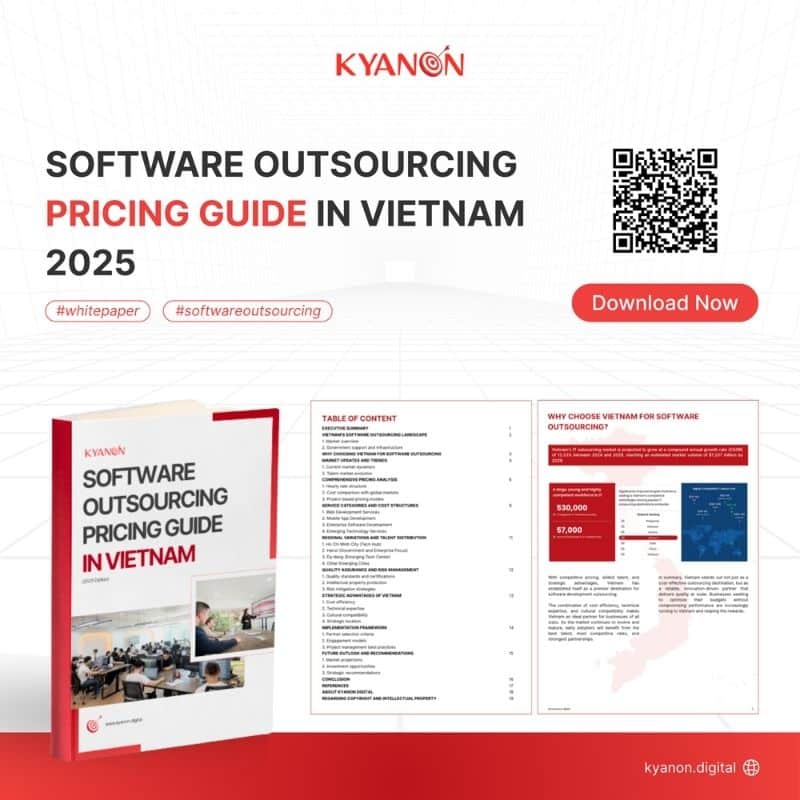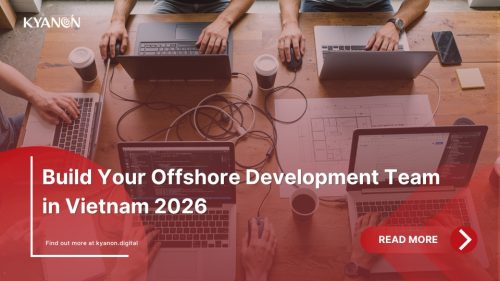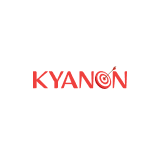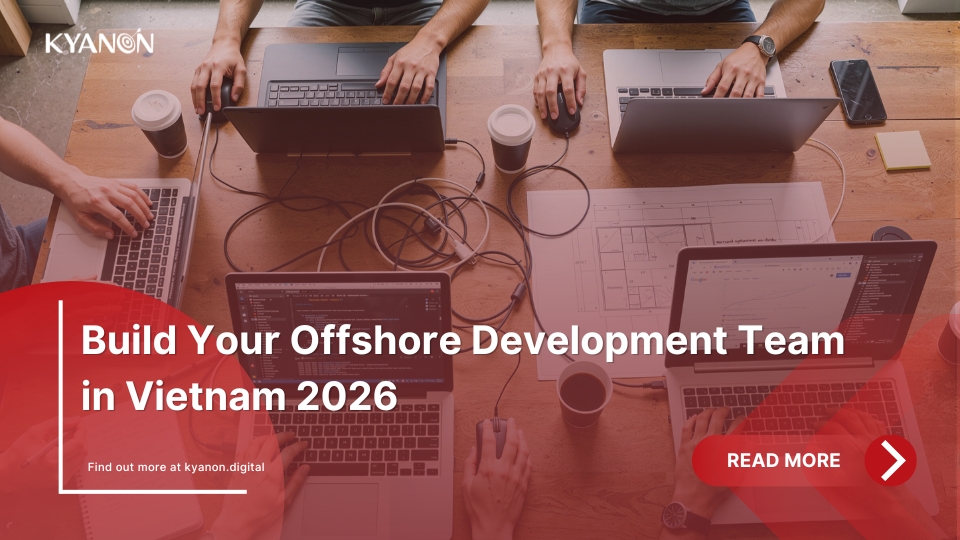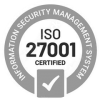As digital projects evolve in complexity, knowing how to scale your dedicated software development team becomes crucial for maintaining delivery speed and product quality. According to Grand View Research, global IT outsourcing is expected to reach 744,623.5 million USD in 2024, while IBM’s Agile Scaling Framework highlights the importance of structured team growth to support enterprise agility. As projects evolve, the ability to efficiently scale dedicated software development teams becomes crucial for maintaining momentum and delivering value.

To effectively expand your team without compromising efficiency, explore the practical approaches and proven strategies outlined below.
Further reading:
- The Benefits Of Dedicated Team Model For Startup Agility
- 9 Main Factors Make A Great Dedicated Software Team
- From MVP to Robust Product: Hire Dedicated Development Team For Startup Growth
Why scaling is the true test of a dedicated team model?
While building a dedicated development team is often considered a strategic win, the real challenge begins when it’s time to scale. Many projects falter not because of poor execution, but because they are unprepared for the operational complexity that comes with rapid team expansion – or sudden contraction.
Why do most projects struggle during rapid scale or contraction?
Rapid project scaling often fails due to inflexible initial team structures, leading to unclear roles, poor communication, and difficult onboarding. Dedicated hiring with knowledge transfer and role modularity is crucial to avoid quality and morale issues. Conversely, poorly managed contraction, especially without flexible outsourcing, risks knowledge loss and declining morale. Responsible scaling down is as important as effective scaling up.
The hidden cost of team ramp-up
Scaling a dedicated software development team sounds promising, more hands, faster delivery, right? But in reality, ramping up isn’t just about onboarding more people. If not managed properly, ramp-up comes with hidden costs that can erode productivity, inflate budgets, and derail timelines. Here are three common consequences:
- Missed sprint commitments: When new developers are brought in mid-project, they often lack full context: business goals, technical decisions, coding standards, or product nuances. This slows down their contributions and often disrupts sprint velocity. Studies show that Agile teams with strong interpersonal dynamics are 2.5 times more likely to report successful project outcomes. (Cogent University)
- Rework due to misalignment: While some level of rework is expected, excessive rework can significantly impact project timelines, budgets, and overall productivity. It can also negatively affect developer morale and the overall quality of the software product, according to ScopeMaster. (ScopeMaster)
- Chaos in collaboration and workflow: Ramping up without proper planning creates chaos: unclear responsibilities, inconsistent workflows, communication breakdowns, and integration headaches. Without clear onboarding paths and tooling, the team may operate like a group of solo contributors instead of a cohesive unit.
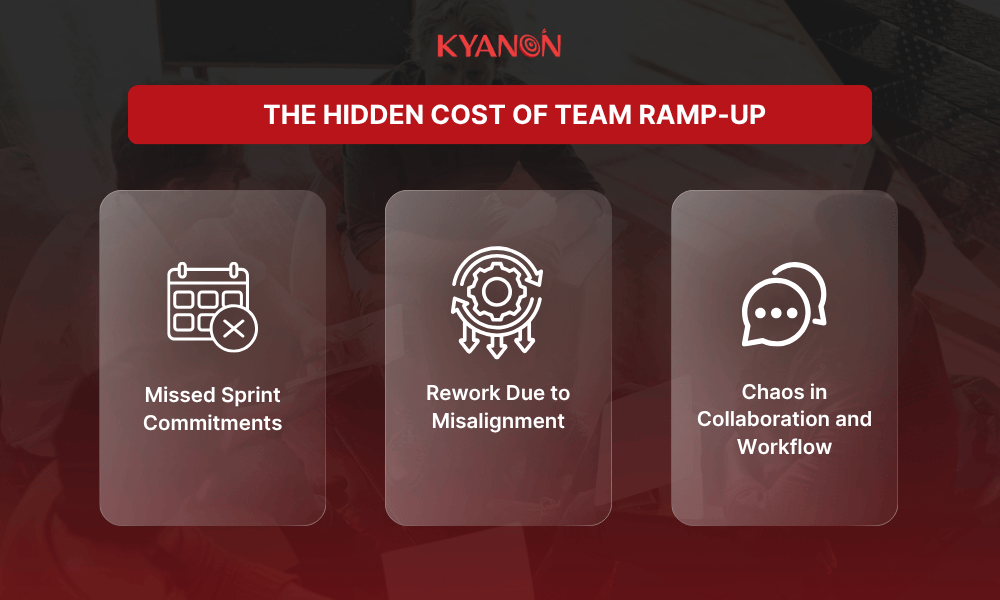
When companies hire dedicated teams for scaling projects, what goes wrong?
When companies hire dedicated teams to support scaling efforts, teams are often scaled reactively, rather than as part of a broader strategic roadmap. Without clear integration plans, even high-performing teams can become siloed, resulting in misaligned priorities, fragmented communication, and delayed feature rollouts. Hence, productivity can stall – despite the increase in headcount.
The issue is often compounded when companies neglect to implement scaling dedicated teams strategies tailored to agile workflows, as they tend to overlook the importance of knowledge management and communication protocols. As a result, duplicated work, inconsistent quality, and delivery delays become common. Effective scaling requires more than just adding talent – it demands operational maturity and strategic foresight.
Understanding the flexible dedicated team model
What a flexible dedicated team model actually means?
A flexible dedicated team model is a scalable engagement approach where you hire a dedicated development team that can dynamically adjust in size and skill set based on real-time project needs. Unlike fixed team setups, this model enables quick role-based scaling – developers, QA, DevOps, or PMs – alongside seamless onboarding, all without disrupting workflow or delivery momentum.
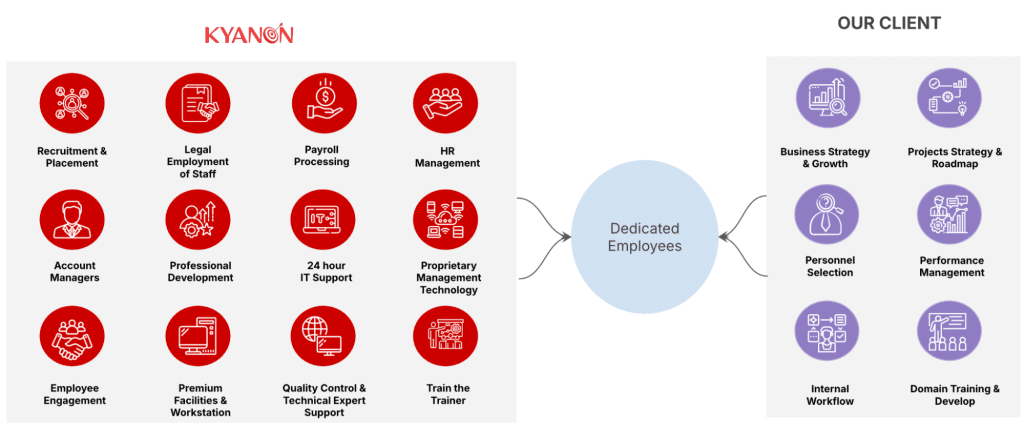
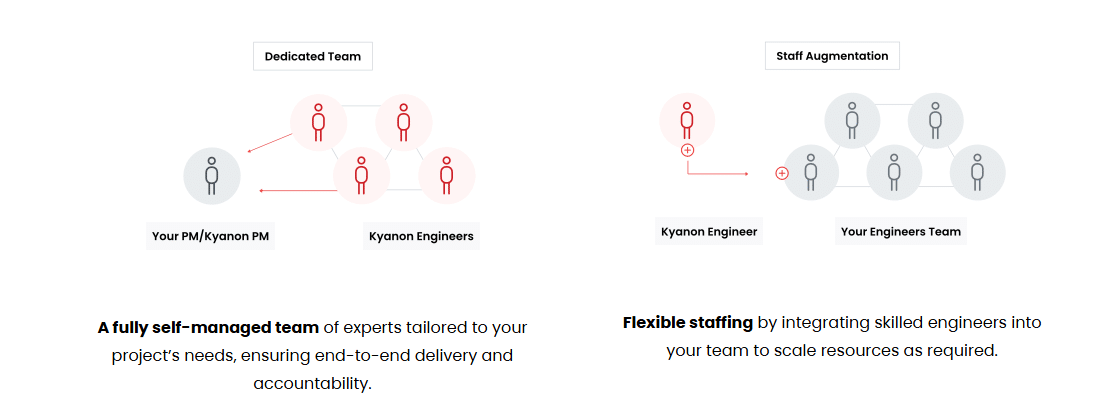
Components of a flexible dedicated team
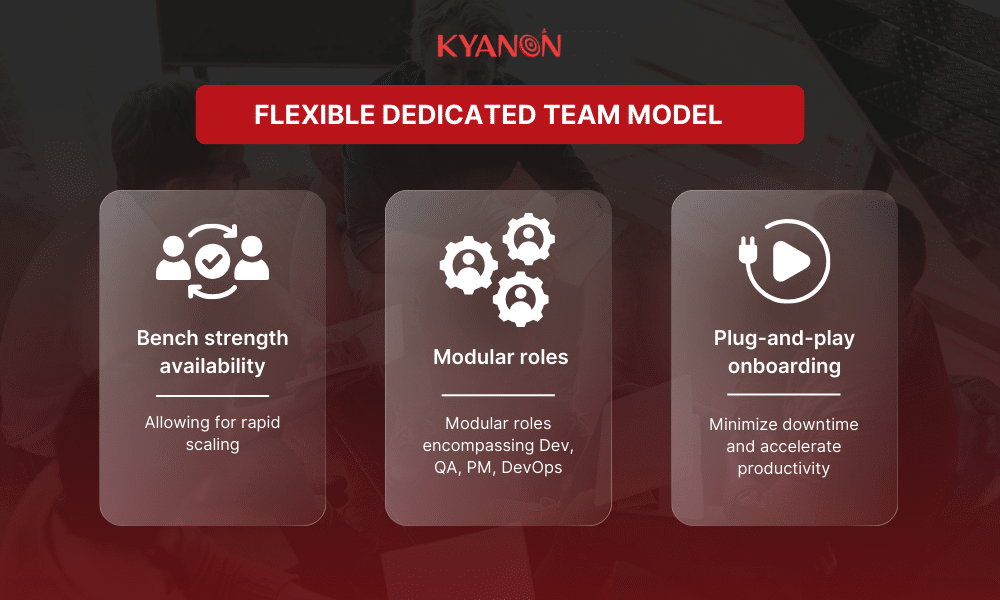
These elements collectively ensure that your team can swiftly respond to changing project requirements, maintain high performance, and deliver quality outcomes consistently. By leveraging such a structured yet flexible approach, organizations can navigate the complexities of software development with greater agility and confidence.
Benefits of scaling dedicated teams
One of the primary advantages of scaling dedicated teams with flexibility is elasticity. As product roadmaps shift – whether due to pivoted business goals or market feedback – the team size and structure can adapt with minimal friction. This agility allows leaders to stay responsive while keeping long-term planning intact.
Flexible outsourcing models also enable faster time-to-market without the administrative burden of starting a full hiring cycle. By maintaining a lean core team and augmenting it strategically, businesses can speed up releases and manage resources more efficiently across phases.
Transform your ideas into reality with our services. Get started today!
Our team will contact you within 24 hours.
How to scale up your dedicated team smoothly?
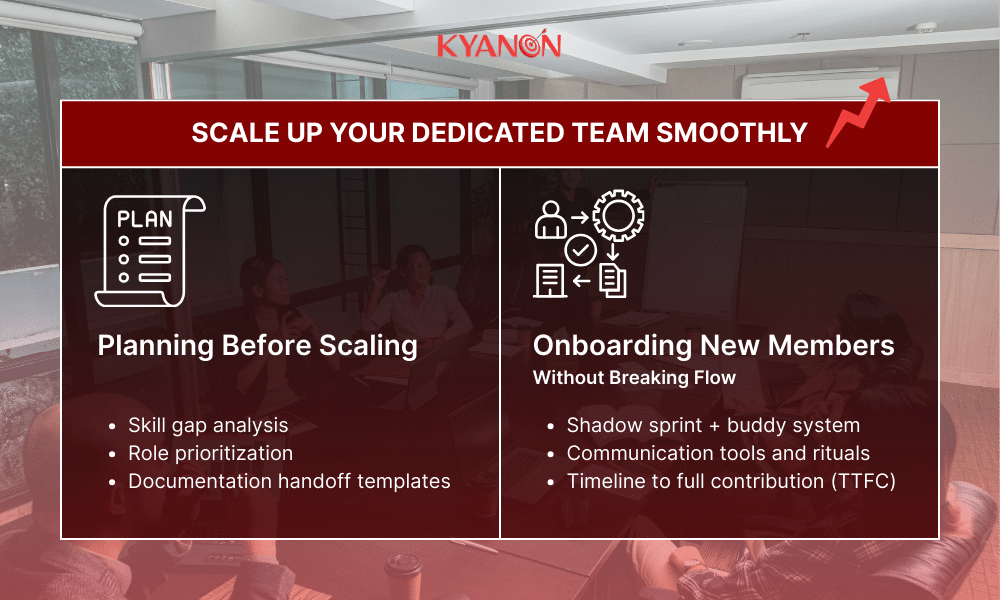
1. Planning before scaling
Before scaling any dedicated development team, organizations must conduct a thorough skill gap analysis to identify exactly which capabilities are missing or need reinforcement. This enables smarter hiring and avoids overstaffing or underutilizing talent. Prioritizing roles based on the product roadmap – whether it’s backend development, DevOps, or QA – ensures that scaling aligns with actual delivery needs, not assumptions.
Beyond role planning, many scaling failures stem from a lack of operational readiness. Implementing documentation handoff templates early on creates a foundation for consistency and efficiency. Teams using dedicated hiring solutions must treat documentation as a strategic asset – ensuring new members ramp up quickly without interrupting sprint velocity.
2. Onboarding new members without breaking flow
Smooth onboarding starts with a structured shadow sprint and a peer-led buddy system. These approaches reduce the learning curve and enable new developers to absorb team culture, codebase practices, and task ownership more effectively. For scaling dedicated teams, this phase is critical to avoid introducing friction or slowing down momentum mid-project.
To accelerate time to full contribution (TTFC), teams should standardize communication rituals – standups, retrospectives, and async updates – through reliable digital tools. Companies leveraging flexible outsourcing models should ensure alignment not only on tools but also on cultural expectations, which directly influence remote collaboration and onboarding success.
3. Sample ramp-up timeline
Below is a structured Sample Ramp-Up Timeline for scaling a dedicated software development team. This timeline outlines key milestones and activities over a typical 90-day onboarding period.
|
Timeframe |
Milestones |
Activities |
| Day 1 | Orientation & Set up | – Access to code repositories and development environments
– Introduction to team members and project overview – Completion of administrative tasks and compliance training |
| Week 1 | Initial Integration | – Participation in shadow sprints
– Assignment of a mentor or buddy – Familiarization with codebase and development workflows |
| Month 1-2 | Active Contribution | – Independent handling of minor tasks or bug fixes
– Regular code reviews and feedback sessions – Engagement in team meetings and sprint planning |
| Month 3 | Full Integration | – Ownership of significant features or modules
– Participation in on-call rotations (if applicable) – Contribution to process improvements and documentation |
How to scale down without team morale or delivery impact?
Scaling down a dedicated development team is often more complex than scaling up. Abrupt changes in team size can lead to delivery delays, loss of domain knowledge, and a sharp decline in morale. This section outlines structured approaches to downsizing without compromising performance or continuity.
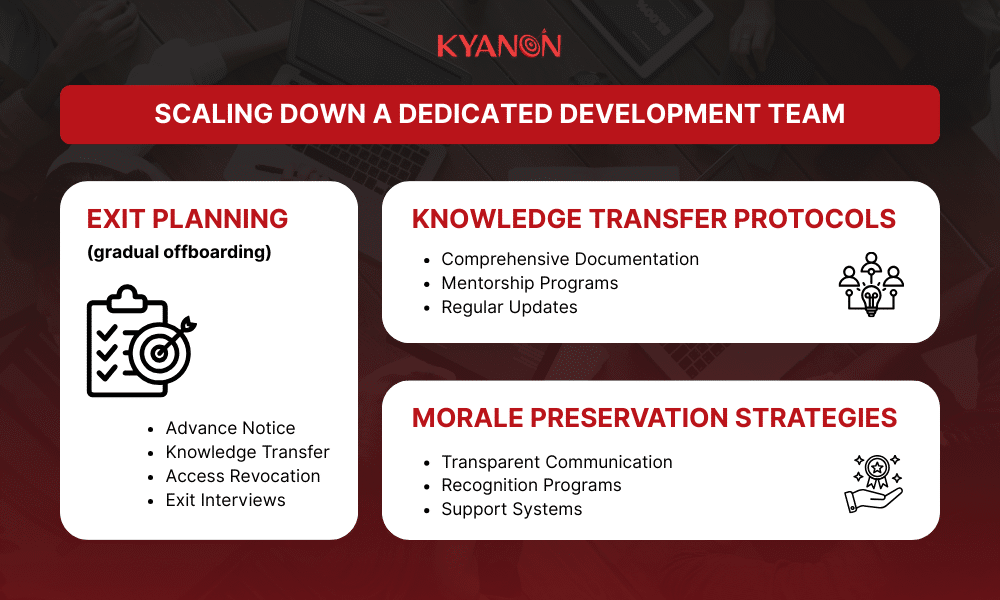
1. Exit planning (gradual offboarding)
Implementing a structured exit plan is crucial when reducing a dedicated development team. Gradual offboarding allows for the seamless transition of responsibilities, minimizing disruptions to ongoing projects. Key steps include:
- Advance Notice: Providing sufficient lead time for transitions.
- Knowledge Transfer: Ensuring critical information is documented and shared.
- Access Revocation: Systematically removing access to sensitive systems.
- Exit Interviews: Gathering feedback to improve future processes.
These practices ensure that the departure of team members does not negatively impact project timelines or quality.
2. Knowledge transfer protocols
Effective knowledge transfer is essential to maintain continuity during team scaling. Establishing standardized protocols ensures that valuable insights and expertise are retained within the organization. Strategies include:
- Comprehensive Documentation: Creating detailed records of processes and systems.
- Mentorship Programs: Pairing departing employees with current team members for hands-on training.
- Regular Updates: Keeping documentation and training materials current.
By prioritizing knowledge transfer, organizations can safeguard against the loss of critical information and maintain operational efficiency.
3. Morale preservation strategies
Maintaining team morale during downsizing is vital, particularly in blended teams comprising both internal and external members. Strategies to preserve morale include:
- Transparent Communication: Clearly articulating the reasons for changes and the future vision.
- Recognition Programs: Acknowledging contributions and achievements to foster a sense of value.
- Support Systems: Providing resources such as counseling or career transition assistance.
These approaches help in sustaining a positive work environment, ensuring that remaining team members stay engaged and productive.
Best practices for scaling dedicated teams
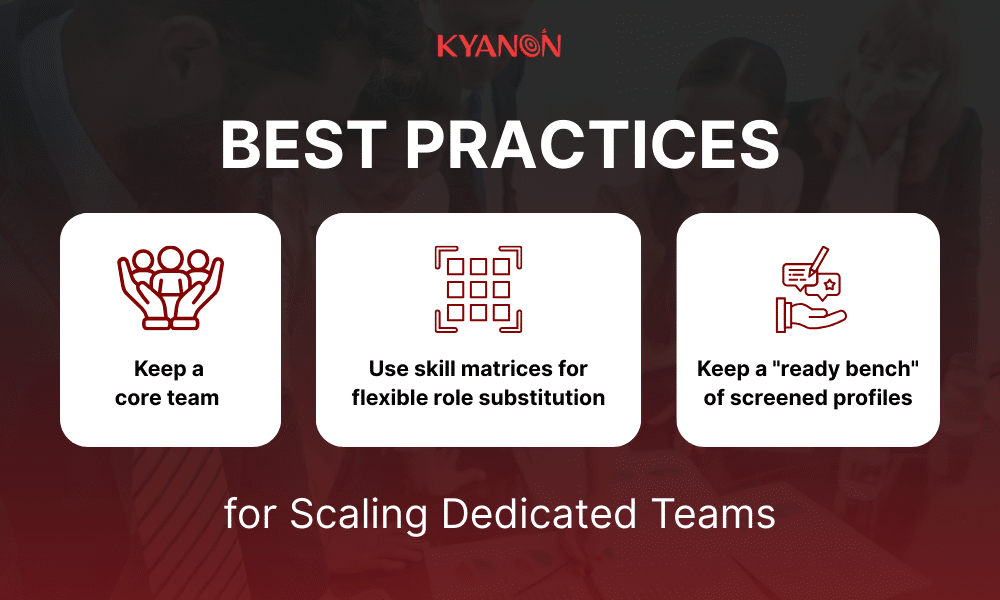
1. Keep a core team
Maintaining a stable core within your dedicated development team ensures continuity and preserves institutional knowledge. This core typically comprises key developers and architects who are deeply familiar with the project’s intricacies. By keeping this nucleus intact, organizations can ensure consistent leadership and technical direction.
To adapt to evolving project demands, it’s effective to scale peripheral roles such as QA, BA, DevOps… This approach allows for flexibility in addressing specific needs without disrupting the core team’s cohesion.
2. Use skill matrices for flexible role substitution
Implementing a skill matrix provides a comprehensive overview of the team’s competencies, highlighting areas of strength and identifying skill gaps. This tool facilitates informed decision-making when allocating tasks and planning for professional development.
By regularly updating the skill matrix, organizations can ensure that team members are cross-trained and capable of stepping into different roles as needed. This flexibility is crucial for maintaining productivity during transitions and scaling efforts.
3. Keep a “ready bench” of screened profiles
Establishing a “ready bench” of pre-vetted professionals enables rapid scaling in response to project needs. This proactive approach reduces the time and resources required for recruitment, ensuring that qualified candidates are available when needed.
Maintaining this pool of talent allows organizations to respond swiftly to changing demands, minimizing downtime and maintaining momentum in development cycles.
How dedicated team at Kyanon Digital helped accenture achieved success with a flexible dedicated team
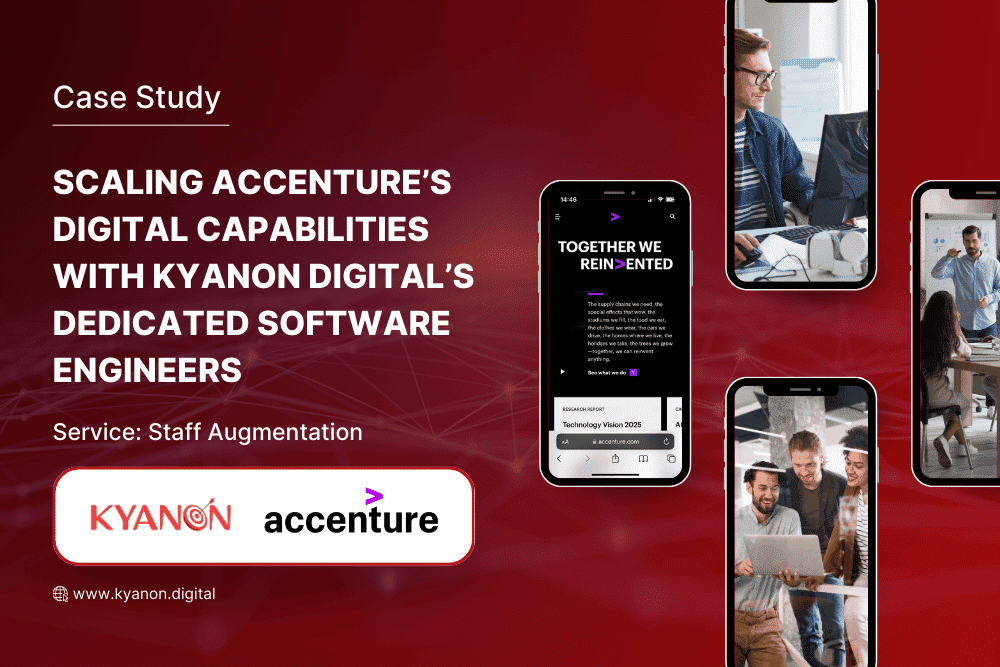
By deploying a dedicated team model, Kyanon Digital enabled Accenture to rapidly scale its digital capabilities, addressing both speed and quality demands for large-scale transformation projects. The engineering team seamlessly integrated with Accenture’s global processes, ensuring alignment in delivery standards and agile practices.
This strategic partnership allowed Accenture to accelerate product development cycles without compromising on quality or governance. The scalable and flexible team structure helped manage evolving project scopes efficiently. As a result, Accenture successfully met critical business goals while optimizing operational efficiency through trusted outsourcing.
Find out more here.
Red flags to avoid
Scaling dedicated teams without structured oversight can lead to silent inefficiencies that undermine long-term delivery goals. Common red flags—such as imbalance in role seniority, undocumented handovers, and fragmented onboarding—often surface too late, impacting both morale and output. Recognizing these red flags early helps ensure sustainable team growth and consistent delivery outcomes.
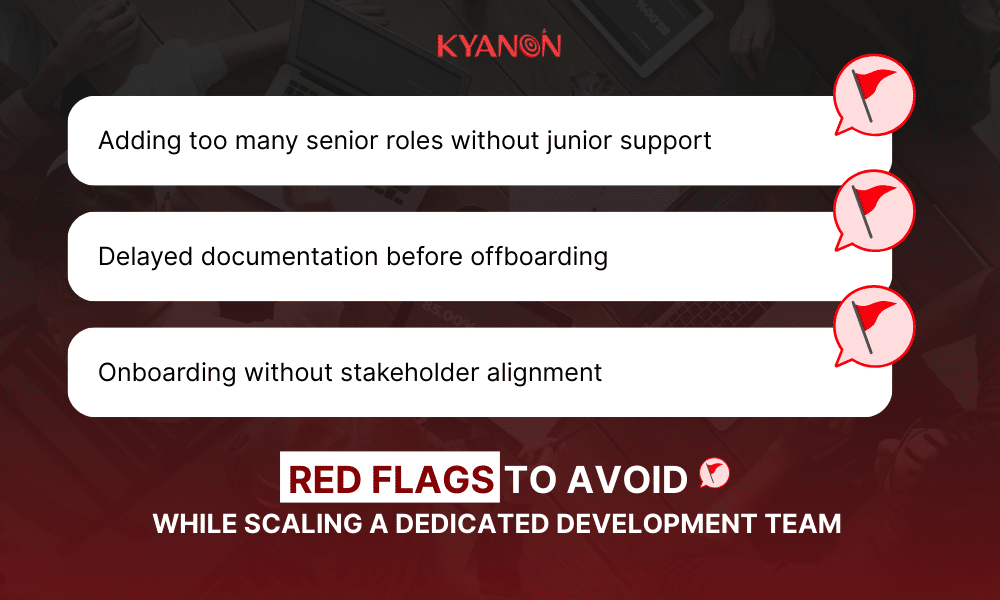
Adding too many senior roles without junior support
Overloading a dedicated development team with senior engineers, without a balanced inclusion of junior talent, can lead to inefficiencies and hinder knowledge transfer. Senior developers may find themselves engaged in tasks that don’t fully utilize their expertise, leading to potential dissatisfaction and increased costs. Moreover, the absence of junior team members can impede the development of a robust talent pipeline, essential for long-term sustainability.
Integrating junior developers into the team structure not only fosters mentorship opportunities but also ensures a more dynamic and adaptable workforce. This balanced approach promotes a culture of continuous learning and innovation, as junior members bring fresh perspectives while benefiting from the guidance of seasoned professionals.
Delayed documentation before offboarding
Postponing documentation until the offboarding phase can result in knowledge gaps and disrupted workflows. Comprehensive documentation should be an ongoing process, ensuring that critical information is captured and accessible. This proactive approach facilitates seamless transitions and maintains continuity in development efforts.
Onboarding without stakeholder alignment
Onboarding without proper stakeholder alignment can result in fragmented communication, unclear expectations, and inconsistent role definitions – ultimately delaying team integration and productivity. Establishing a unified onboarding process that involves all key stakeholders helps ensure clarity, fosters collaboration, and aligns new team members with broader organizational objectives.
KPI checklist for scalable dedicated teams
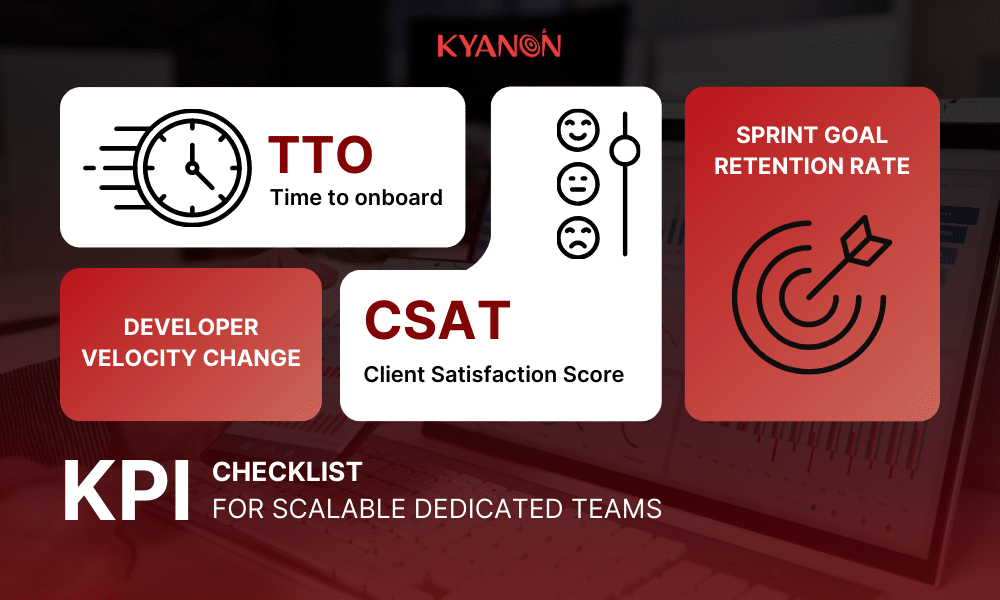
1. Time to onboard (TTO)
Time to onboard measures the duration required for new team members to become fully productive. A streamlined onboarding process not only accelerates integration but also minimizes disruptions to ongoing projects. Efficient onboarding is indicative of well-structured training programs and clear documentation, which are essential for maintaining development momentum.
2. Developer velocity change
Developer velocity measures how efficiently software development teams deliver high-quality outputs over time. Tracking changes in this metric provides insight into productivity trends, process bottlenecks, and the impact of organizational shifts. Maintaining consistent developer velocity – while balancing quality and delivery cadence – is critical for sustainable performance, especially in agile environments where team dynamics and workload vary sprint by sprint.
3. Sprint goal retention rate
Sprint Goal Retention Percentage tracks how consistently a development team meets its planned sprint targets. High-performing agile teams typically achieve 85% or more of their sprint commitments, indicating robust planning, reliable velocity, and strong execution. This metric is essential for reviewing long-term performance and ensuring delivery reliability, even as scope changes are naturally introduced during a sprint.
4. Client satisfaction score (CSAT)
Client Satisfaction Score (CSAT) gauges customer contentment with services provided, often through post-interaction surveys. Tracking CSAT before and after team changes offers insights into the impact of structural adjustments on client perceptions, enabling proactive enhancements to service quality.
Scale your dedicated software development team with Kyanon Digital

We’re a Tech Partner, Not a Recruiter
We build your team strategically, aligning talents with your software vision and roadmap, not just job requirements. With ongoing upskilling and expert support from our Center of Excellence, your talent stays ahead of challenges and delivers results.
Comprehensive Talent Ecosystem
Kyanon Digital talent ecosystem encompasses over 50,000 technology professionals
- Internal Talent Core: 300+ professionals
- K-Fresh Program: Nurturing Future Digital Leaders from 18 Universities in Vietnam
- External Talent Network: 15,000+ premium candidates
- Partner Network: 1,000+ trusted partners
Your One-Stop Talents Impact Solution
We manage from talent acquisition to HR management for your tech workforce, freeing your team to focus on core business and innovation.
Conclusion
In the dynamic realm of software development, scaling a dedicated team transcends mere expansion – it necessitates strategic foresight, operational agility, and a commitment to continuous improvement. This comprehensive guide has delved into the intricacies of scaling dedicated development teams, highlighting the importance of flexibility, structured onboarding, and vigilant monitoring of key performance indicators (KPIs) to ensure sustained success.
Kyanon Digital is a trusted software engineering partner that delivers innovative, user-focused solutions that address complex challenges and drive measurable business impact. Contact us to transform your idea into reality today!
Key Takeaways:
- Strategic planning: Before scaling, conduct a thorough skill gap analysis to identify specific needs, ensuring that team expansion aligns with project objectives and avoids resource misallocation.
- Structured onboarding: Implementing standardized onboarding processes, such as shadow sprints and mentorship programs, accelerates integration and minimizes disruptions, fostering a cohesive team environment.
- Flexible team models: Adopting a flexible dedicated team model allows for dynamic adjustment of team size and composition, facilitating rapid response to evolving project requirements without compromising workflow continuity.
- Monitoring KPIs: Regularly tracking KPIs like Time to Onboard (TTO), Developer Velocity Change, Sprint Goal Retention Rate, and Client Satisfaction Score (CSAT) provides actionable insights into team performance and client satisfaction, guiding informed decision-making.
References:
Insight into the development industry from:
- IT services outsourcing market, Grand View Research
- What is a scaled agile framework (safe)?, IBM
- Team topologies, Matthew Skelton and Manuel Pais
- 4 reasons why outsourcing software development works, Accelerance
Strategic team scaling and agility frameworks from:
- Find the right pricing model to lower the cost of outsourcing, Accelerance
- Team topologies excerpt, InfoQ
- What is a scaled agile framework (SAFe)?, IBM
- Skill matrix: Building a flexible team, TeamGuru
- Working in agile teams: Soft skills for efficient collaboration and delivery, Cogen University
- Rework on software projects and how to reduce it, Scope Master
Developer onboarding and offboarding practices from:
- The ultimate guide to effective developer onboarding, Primotly
- Developer productivity for humans, Part 5: Onboarding and ramp-up, Collin Green & Ciera Jaspan et al.
- Improving developer onboarding, Multiplayer
- Employee offboarding excellence: The 5-Step strategic framework, Lift HCM
- The onboarding process: A review, Ory Pinco et al.
- 5 best practices when offboarding development teams, Clutch
Team dynamics and productivity insights from:
- How to mix junior and senior engineers on a team, LeadDev
- Your team is feeling undervalued and unappreciated. How can you turn the tide and boost morale?, LinkedIn Advice
- 10 strategies to build team morale, Vantage Circle
- Unlocking the benefits of staff augmentation over traditional staffing, Accelerance
Developer efficiency and velocity tracking from:
- What is development velocity and how to measure it?, Axify
- Sprint target completion, Plandek
- How to measure customer satisfaction KPI: NPS, CSAT, CES, & CLI, Customer Alliance
- Streamlining employee onboarding time with KPIs, Profit.co
Get the Vietnam Software Outsourcing Pricing Guide 2025
Your shortcut to Vietnam’s outsourcing costs and key market insights.

Why work with Kyanon Digital?
- Expertise Trusted by Fortune 500 Clients
With deep experience serving Fortune 500 companies, we deliver tailored, high-impact solutions that meet the unique demands of global enterprises. - A World-Class IT Team
Our 500+ IT experts—spanning consulting, project management, technical architecture, software engineering, QA, DevOps, and AI/ML—are committed to excellence in every project. - Quality at the Core
Certified under ISO 9001, our quality-first approach guarantees precision, reliability, and continuous improvement. - Uncompromising Security
ISO 27001-certified, we integrate robust security into every process, leveraging advanced technologies to protect your data against evolving threats.



